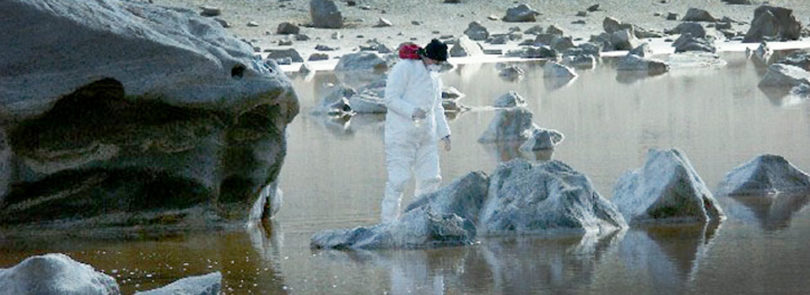In so many ways, Don Juan Pond in the Dry Valleys of Antarctica is one of the most unearthly places on the planet. An ankle-deep mirror between mountain peaks and rubbled moraine, the pond is an astonishing 18 times saltier than the Earth’s oceans and virtually never freezes, even in temperatures of more than 40 degrees below zero Fahrenheit.
Now, a research team led by biogeochemists from the University of Georgia has discovered at the site a previously unreported chemical mechanism for the production of nitrous oxide, an important greenhouse gas. Possibly even more important, the discovery could help space scientists understand the meaning of similar brine pools in a place whose ecosystem most closely resembles that of Don Juan Pond: Mars.
The research, published in the journal Nature Geoscience, adds an intriguing new variable to growing evidence that there has been-and may still be-liquid water on Mars, a usual prerequisite for the formation of life. In fact, the new findings could help space scientists develop sensors for detecting such brines on Mars-thus narrowing the search for places where life may exist.
“The pond’s soils and brines and the surrounding rock types are similar to those found on Mars,” said Samantha Joye, a faculty member in the department of marine sciences in the Franklin College of Arts and Sciences and lead author on the paper. “So it provides an ideal location to assess microbial activity in extreme environments. While we did not detect any ‘bio-gases’ such as hydrogen sulfide and methane, we did, surprisingly, measure high concentrations of nitrous oxide, which is normally an indicator of microbial activity. We needed to find out whether a non-organic process could account for this nitrous oxide production.”
The pond, which is a roughly 1,000- by 400-meter basin, is the saltiest body of water on Earth by far, some eight times saltier than the Dead Sea. Even with no life-forms present in the pond, the team was able to measure nitrous oxide, perhaps best known to most people as the “laughing gas” used in dental procedures. (The amounts measured in the air were beneath a level that could make a person light-headed or giddy, as “laughing gas” can.)
“What we found was a suite of brine-rock reactions that generates a variety of products, including nitrous oxide and hydrogen,” said Joye. “In addition to Don Juan Pond, this novel mechanism may occur in other environments on Earth as well and could serve as both an important component of the Martian nitrogen cycle and a source of fuel [hydrogen] to support microbial chemosynthesis.”
The discovery of the new mechanism opens numerous questions that must be studied, including the possibility that the process is taking place in other extreme Antarctic habitats or that it might contribute to nitrous oxide in temperate soils-a possible new clue to understanding greenhouse gases involved in global warming.
The most crucial result, however, may be in understanding how similar brine pools on Mars might work and whether they could support life.
The research was supported by grants from the National Science Foundation’s Antarctic Organisms and Ecosystems Program and the McMurdo Microbial Observatory Program.







